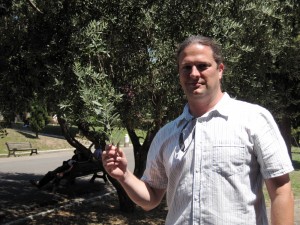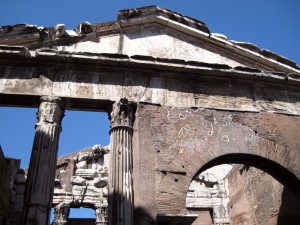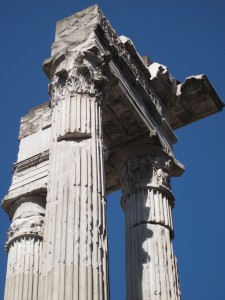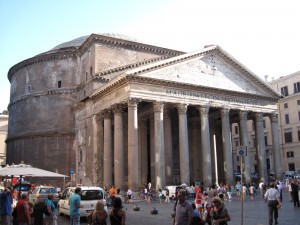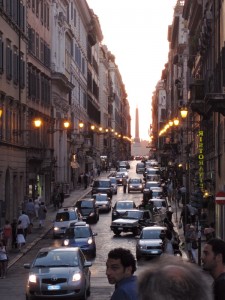After dropping off the rental car, taking a shuttle in from the airport, and getting settled in our hotel (Hotel Assisi, near the train station), we headed out to explore the city. Our first stop was to pick up my brother’s leaf. For the last few times we’ve gone abroad, my brother will get on Google Earth and pick out a tree somewhere near a place were we are going to be visiting. In the course of the trip, we track down the tree, get a leaf to take home to him, and take a photo. This trip’s tree was in the Parco del Colle Oppio, just to the northeast of the Colosseum. And, man, it was hot. And dry. But we got the leaf.
The Colosseum and the nearby Arco di Costantino don’t really look real up close. In fact, a lot of things really don’t look real in Rome, but you have to learn to just trust your eyes and enjoy what you can, trying your best to ignore the crush of tourists, and hawkers that follow tourists, and guys dressed as Roman soldiers that want you to take a picture with them, and tour guides that chide you in your native language if you don’t use their services.
Perhaps the most interesting physical thing about the Colosseum is the sheer number of holes in its ancient structural walls. Near every intersection of the marble blocks in the travertine pillars facing out has a huge hole in it, some so large that you can’t understand how the entire structure can stay up. Apparently, I’m not the only one that noticed this. The odd thing about these holes is that they formed so long ago that no one is exactly sure what caused them. The leading theory is that iron clamps were in place to hold the blocks together but were taken out in the 5th century to be used for other things, during a period the Colosseum was starting to be used as an unofficial building material warehouse.
Another of the most interesting remains we came across is the Porticus Octaviae, which has a fascinating history and allows the visitor to see several different styles of ancient architecture, materials, and architectural purpose in the same building, while standing the exact same spot. There is something that stirs within you imaging this place as a library, curia, and fish market through the years, this now ramshackle, almost dangerous-looking ruin located a dozen or more feet below the current level of the street. You can see the ancient (and largely destructive) attempts at patching it, to keep it a viable building for daily use.
Nearby the Porticus Octaviae is the Temple of Apollo, or what stunningly remains of it.
Rome wasn’t all old carved marble to us, though. We wanted to experience some of the street life, and we found some of the best local flavor and least tourists, in the old part of town at least, in the Trastevere area. I mean, who could not love a place that could make a meringue cookie this large?
The Pantheon was a treat, as well, but we wanted to spend more time than we had left in the day, so we bookmarked the spot in our mind and agreed to come back tomorrow.
While walking back to our hotel, we practically stumbled by the famous Trevi Fountain, which only has its majesty diminished due the crushing crowds that jostle for position near the edge of the water and along the steps beside. The scene on the fountain confused me, but I’ve since learned that is depiction of virgins leading Roman citizens to the source of pure water outside of Rome that ends up in the fountain. Ironically, the carvings of natural rocks, which are actually carved out of natural rock (marble), make the fountain so striking, in addition to it’s sheer size.
Once the blasting heat of the sun starts to fade, Rome really starts to turn on the charm. Street life has this kind of intimacy in Rome, one where you can’t help bumping into strangers as you scan your surroundings for the ever-present little nuggets of art, tiny treasures that Romans have come to expect and internalize and take for granted.
I had come expected a gritty city, but Rome had begun to charm me, despite the heat of mid-July.
